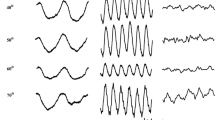Summary
The relative spectral sensitivity of the photopic component of the human electroretinogram was measured for wave lengths between 404 and 672 mμ in a state of moderate light adaptation. Light stimuli at a constant frequency of 32 per second were used to avoid scotopic contamination.
With stimulation of a small central area including the fovea and parafoveal zone, the photopic spectral sensitivity agrees roughly with psychophysical measurements for the red and green portions of the spectrum. However, at shorter wavelength there is a higher sensitivity determined by this method as compared to any available foveal luminosity curves. This blue discrepancy is not apparent when the “electroretinal” spectral sensitivity curves are compared to Wald's peripheral (8°) photopic luminosity curves.
Large-area stimuli which illuminate the retina further peripherally cause an increase in blue sensitivity which is maximal at about 460 mμ and is more pronounced at higher intensities. Nyctalopes show the same increase in blue sensitivity as normals when large-area stimuli are used.
The spectral sensitivity of the photopic component varies between protanopes, protanomalous, and normal subjects, with protanopes showing the greatest loss in sensitivity in the region of the longer wavelength as compared to normals, while the sensitivity of protanomalous subjects fell between the protanopes and normals. The maximum loss of sensitivity in the protanopes in the long wavelength end of the spectrum was at 585 mμ.
Similar content being viewed by others
Literatur
Adrian, E. D.: The electrical response of the human eye. J. Physiol. (Lond.) 104, 84–104 (1945).
Armington, J. C.: A component of the human electroretinogram associated with red color vision. J. Opt. Soc. Amer. 42, 393–401 (1952).
Electrical responses of the light adapted eye. J. Opt. Soc. Amer. 43, 450–456 (1953).
Amplitude of response and relative spectral sensitivity of the human electroretinogram. J. Opt. Soc. Amer. 45, 1058–1064 (1955).
Armington, J. C., and W. R. Biersdorf: Flicker and color adaptation in the human electroretinogram. J. Opt. Soc. Amer. 46, 393–400 (1956).
Best, W., u. K. Bohnen: Über den „off-Effekt“ im Elektroretinogramm des Menschen. Albrecht v. Graefes Arch. Ophthal. 158, 568–577 (1957).
Burian, H. M., and L. Allen: A speculum contact lens electrode for electroretinography. EEG Clin. Neurophysiol. 6, 509–511 (1954).
Coblentz, W. W., and W. B. Emerson: Relative sensitivity of the average eye to light of different colors and some practical applications to radiation problems. Bull. Bureau of Standarts 14, 167–234 (1918/19).
Dodt, E.: Elektroretinographische Untersuchungen zur Analyse des Flimmerphänomens im menschlichen Auge. Ber. dtsch. ophthal. Ges. 57, 242–245 (1951).
Physical factors in the correlation of ERG spectral sensitivity curves with visual pigment. Amer. J. Ophthal. 1958 (im Druck).
Dodt, E., u. V. Elenius: Spektrale Sensitivität einzelner Elemente der Kaninchennetzhaut. Pflügers Arch. ges. Physiol. 262, 301–306 (1956).
Dodt, E., and J. B. Walther: Fluorescence of the crystalline lens and electroretinographic sensitivity determinations. Nature (Lond.) 1958a, 286–287.
Photopic sensitivity mediated by visual purple. Experientia (Basel) 14, 142 (1958b).
Dodt, E., and A. Wirth: Differentation between rods and cones by flicker electroretinography in pigeon and guinea pig. Acta physiol. scand. 30, 80–89 (1953).
Granit, R.: Sensory mechanisms of the retina. Oxford: University Press 1947.
Hecht, S., and Y. Hsia: Colorblind vision I. Luminosity losses in the spectrum for dichromats. J. gen. Physiol. 31, 141–152 (1948).
Johnson, E. P., and T. N. Cornsweet: Electroretinal photopic sensitivity curve. Nature (Lond.) 1954, 614–615.
König, A., u. C. Dieterici: Die Grundempfindungen und ihre Intensitätsverteilung im Spectrum. Sitzungsberichte Kgl. Preuß. Acad. Wiss. Berlin 39, 805–829 (1886).
Le Grand, Y.: Sur la fluorescence du cristalline. Compt. rend. d. séances de l'academ. d. sciences 207, 1128–1130 (1938).
Pitt, F. H. G.: Characteristics of dichromatic vision with an appendix on anomalous trichromatic vision. Great Britain Med. Res. Council. Spec. Rep. Series No. 200 (1935).
Some aspects of anomalous vision. Docum. Ophthalm. 3, 307–317 (1949).
Ranke, G.: Objektive Messung der Lichtzerstreuung in den Augenmedien von Tieraugen. Arbeitsphysiologie 15, 427–447 (1954).
Rushton, W. A. H., and F. W. Campbell: Measurements of Rhodopsin in the living human eye. Nature (Lond.) 1954, 1096.
Human cone pigments. Symposium on visual problems of colour. Teddington, September (1957a).
The lack of red-sensitive pigment in the protanope. Acta physiol. scand. 42, Suppl. 145, 121–122 (1957b).
Schubert, G., u. H. Bornschein: Beitrag zur Analyse des menschlichen Elektroretinogramms. Ophthalmologica (Basel) 123, 396–413 (1952).
Sperling, H. G., and Y. Hsia: Some comparisons among spectral sensitivity data obtained in different retinal locations and with two sizes of foveal stimulus. J. Opt. Soc. Amer. 47, 701–713 (1957).
Talbot, S. A.: Recent concepts of retinal color mechanism. J. Opt. Soc. Amer. 41, 895–918 (1951).
Wadensten, L.: The use of flicker electroretinography in the human eye. Acta Ophthalm. 34, 311–340 (1956).
Wald, G.: Human vision and the spektrum. Science 1945, 653–658.
Walls, G. L., and G. G. Heath: Typical color blindness reinterpreted. Acta Ophthalm 32, 253–297 (1954).
Weale, R.: Colour vision in the peripheral retina. Brit. Med. Bull. 9, 55–60 (1953).
Wright, W. D.: Researches on normal and defective colour vision. London: Kimpton 1946.
Author information
Authors and Affiliations
Additional information
Mit 7 Textabbildungen
Rights and permissions
About this article
Cite this article
Dodt, E., Copenhaver, R.M. & Gunkel, R.D. Photopischer Dominator und Farbkomponenten im menschlichen Elektroretinogramm. Pflügers Archiv 267, 497–507 (1958). https://doi.org/10.1007/BF00361736
Received:
Issue Date:
DOI: https://doi.org/10.1007/BF00361736




